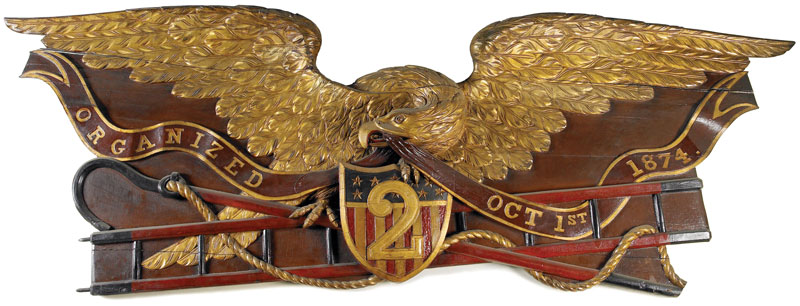 Nahum Littlefield, Jr., carved this ornate sign for the Portland Hook and Ladder Company No. 2 firehouse in 1874. Collection Portland Fire Museum; image by Ellen McDermott, Courtesy Saco Museum
Nahum Littlefield, Jr., carved this ornate sign for the Portland Hook and Ladder Company No. 2 firehouse in 1874. Collection Portland Fire Museum; image by Ellen McDermott, Courtesy Saco Museum
Through much of the 19th century, ships built in Maine were ornamented with carved wooden figureheads and stern boards made from white pine. The Maine Register and Business Directory for 1856 listed 15 carvers working in major shipbuilding centers along the coast, including the Kennebec and Penobscot Rivers.
According to the directory, there were ship carvers in Bath, Newcastle, Thomaston, Belfast, Blue Hill, Richmond, Hallowell, Bangor, and Portland, which, in 1856, had a population of 28,000 and was an important commercial and transportation hub between England and Canada. That year 28 vessels were built in shipyards on the Portland peninsula and across the harbor in Cape Elizabeth, now South Portland.
Back then, no ship was complete without a hand-carved billet head, bowsprit, or stern board. Some of the finest work of this kind was done by Nahum Littlefield, Sr., and his three sons, Charles, Nahum, Jr., and Francis, who worked in a waterfront shop at the head of Central Wharf. Their work, especially that of Nahum Littlefield, Jr., exemplifies an era of fine craftmanship.
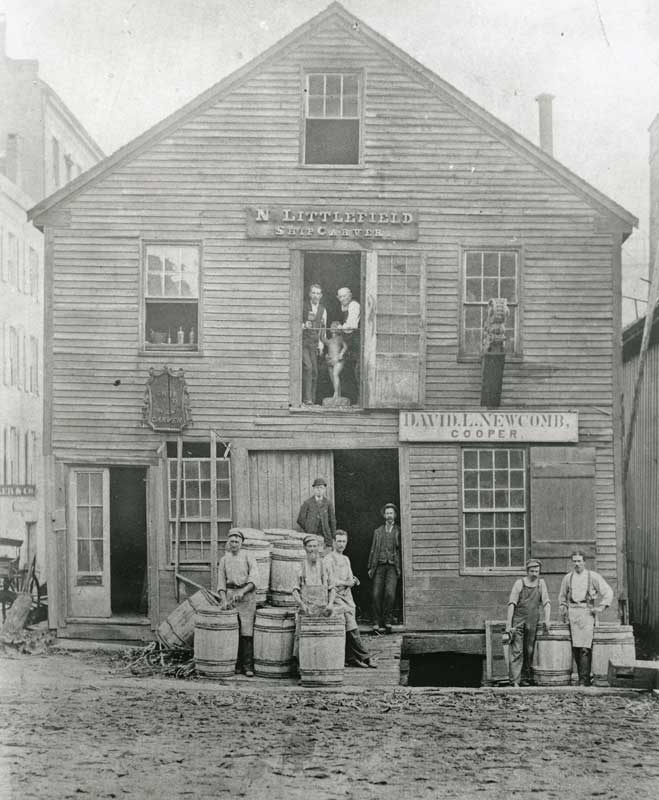 The Littlefield carving shop at the head of Portland’s Central Wharf circa 1870-1880. Little is known about this photo, but it is likely that the man in the upper left holding what looks like a chisel is the carver Nahum Littlefield, Jr. Image courtesy Maine Historic Preservation Commission
The Littlefield carving shop at the head of Portland’s Central Wharf circa 1870-1880. Little is known about this photo, but it is likely that the man in the upper left holding what looks like a chisel is the carver Nahum Littlefield, Jr. Image courtesy Maine Historic Preservation Commission
A native of Wells, the elder Littlefield established himself as a ship carver at the age of 21 in 1830, the year he married Augusta Harris. Their son Charles was born the next year; the next son, Nahum, Jr., in 1832; and Francis in 1838. All three boys learned the art of wood carving from their father, who advertised his business at the “Sign of the Billet Head”—a billet head is a carved scroll that adorns the bow of a ship, and the one on the front of his building served to alert customers of the shop’s location.
While this family of craftsmen must have produced many ship carvings, only one of the senior Nahum Littlefield’s figureheads is mentioned in the newspapers of the 1850s. On November 26, 1856, the Portland Weekly Advertiser published a description of the recently completed Bamberg, a vessel built for New Orleans businessmen by Joseph W. Dyer of Cape Elizabeth. The Advertiser noted that “Her figurehead, representing an eagle’s head and wings, is neatly designed and executed by Nahum Littlefield.”
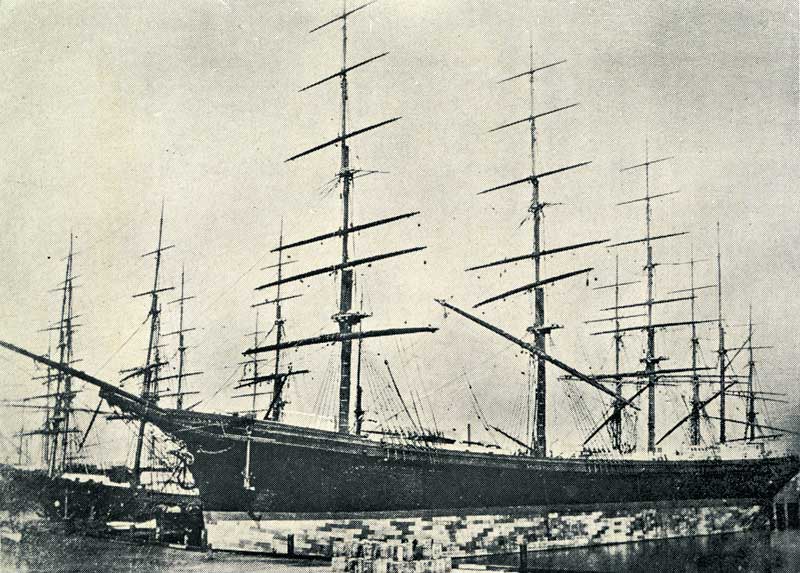 The four-masted barque Ocean King, built in Kennebunk in 1874, was considered the largest ship afloat at the time. The vessel went aground off Oregon in 1887, caught on fire, and sank. Image Courtesy Peabody-Essex Museum
The four-masted barque Ocean King, built in Kennebunk in 1874, was considered the largest ship afloat at the time. The vessel went aground off Oregon in 1887, caught on fire, and sank. Image Courtesy Peabody-Essex Museum
The senior Littlefield died of tuberculosis in 1865. Perhaps in response to their father’s failing health, the three sons formed the firm of Littlefield Brothers in 1863. Operating at their Central Wharf location, they advertised their services in the 1863 Portland Directory and Reference Book as “house, ship, and ornamental carvers and gilders.” Nahum Littlefield, Jr., became the sole survivor of the partnership with the deaths of Francis in 1868 and Charles in 1874. His brother Charles’s death coincided with Nahum Jr.’s carving of the figurehead and stern board of the Ocean King, one of the largest wooden vessels built in Maine during the 19th century. This four-masted ship weighed 2,516 tons and measured 260 feet in length. She was constructed in Captain Nathaniel Lord Thompson’s Lower Village Landing shipyard in Kennebunk for J. Henry Sears and Company of Boston. At the time of her launching in October 1874, her nine-foot figurehead of a bearded Neptune carrying a trident attracted much attention from the press. The Daily Eastern Argus of Portland called it “the largest and best piece of wood carving ever done in Maine.” The Portland Daily Press described the stern board as “stretching across the entire width of the ship and represents Neptune seated in his shell driving a pair of sea horses through a raging sea.”
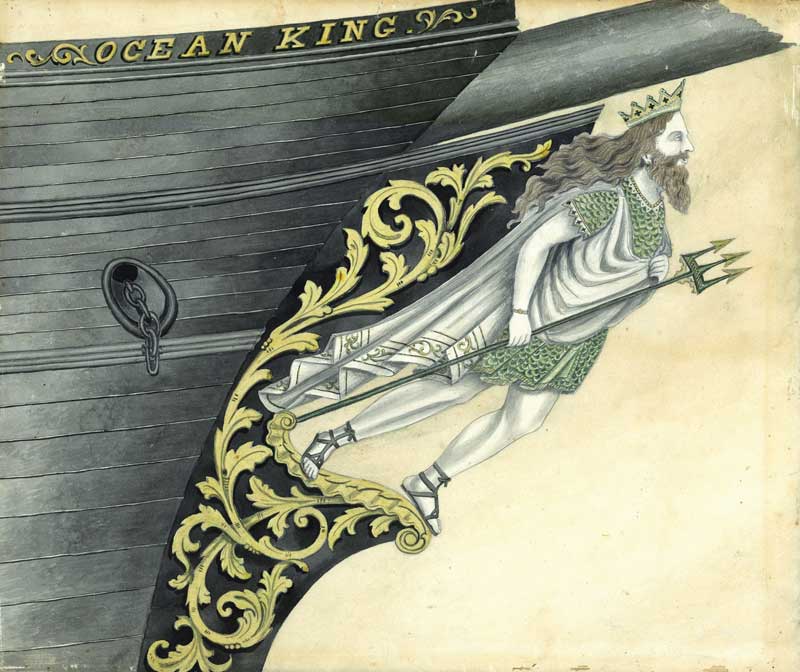 While the figurehead went down with the ship, the design for Nahum Littlefield’s 1874 carving of Neptune for Ocean King remains, a testament to his talent. Courtesy Brick Store Museum, Kennebunk
While the figurehead went down with the ship, the design for Nahum Littlefield’s 1874 carving of Neptune for Ocean King remains, a testament to his talent. Courtesy Brick Store Museum, Kennebunk
Following the success of Nahum Littlefield, Jr.’s carvings for the Ocean King, Captain Thompson commissioned him to make figureheads for two more vessels to be built in Kennebunk. The Defiant was an 1,898-ton ship constructed for Samuel D. Rand and Company of Boston. The June 15, 1875 edition of the Portland Daily Press included the following account of Littlefield’s eight-foot figurehead: “The figure is that of a woman with one foot on the head of a serpent, while the other rests upon his body. Her right hand holds the tail of the reptile while her left grasps a rope which circles her waist. The scales of the serpent are gilded, and he is looking wild and fierce. The figure has on a rich yellow robe, and her feet are encased in sandals. Long light hair hangs over her neck. The features of the woman are bold and defiant, and at the same time true to nature.”
Littlefield carved his third figurehead for Thompson in 1876 for the 2,116-ton Ocean Queen. This ship is believed to have been sold immediately after its launching to J.S. Winslow of Portland, who renamed it for his wife Philena. According to the Portland Daily Press for April 25, 1876, Littlefield’s seven-foot figurehead was dressed in fashionable attire of the period: “She is clad in a large loose gown, and about her form is thrown a large scarf, which she holds firmly in her left hand. Her right hand is holding a beautiful bouquet. Her feet are covered with button boots of modern style. Her hair is dressed and arranged in modern style with the omission of crimps. A large chain, to which is attached a locket, encircles her graceful neck, and beautiful ornaments hang from her ears.”
Thompson’s commissions in the mid-1870s may have marked the peak of Nahum Littlefield, Jr.’s career as a ship carver. Beginning in the 1880s, the demand for figureheads and stern boards began to decline. Littlefield’s last known maritime project was to carve two copies of the Portland city seal to adorn the tops of the paddle boxes of the steamer Portland, which was launched in Bath on October 14, 1889. This large side-wheel paddle steamer provided passenger service between Boston and Portland until she was lost in the Portland gale of November 27, 1898.
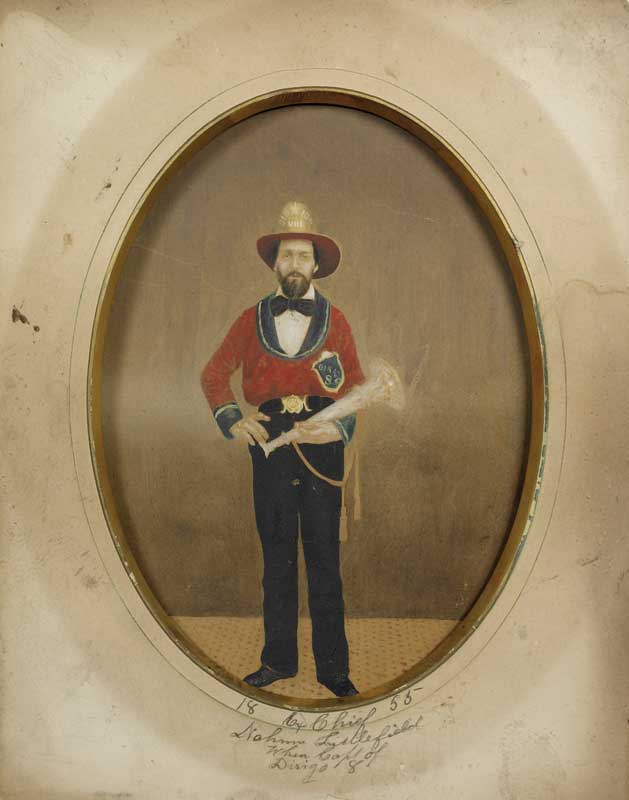 In addition to his work as a carver, Nahum Littlefield, Jr., was also a firefighter who served as a Portland fire chief for a time. The image of him in his fireman’s uniform circa 1855 is in the collection of the Portland Fire Museum. Photo by Ellen McDermott, courtesy Saco Museum
In addition to his work as a carver, Nahum Littlefield, Jr., was also a firefighter who served as a Portland fire chief for a time. The image of him in his fireman’s uniform circa 1855 is in the collection of the Portland Fire Museum. Photo by Ellen McDermott, courtesy Saco Museum
Littlefield adapted to changing times by becoming a house carpenter in 1882, a trade he pursued until his death on June 13, 1916, at the age of 83. His monument in Portland Evergreen Cemetery bears the inscription “Ex-Chief Portland Fire Dept.,” reflecting a major chapter in his life. He volunteered as a firefighter at the age of 18 in 1850 and became a full-fledged member of the department when he turned 21. His more than three decades of service included battling the Great Portland Fire of July 4, 1866, for 24 hours without rest before becoming temporarily blinded by smoke. He headed the department as Chief Engineer from 1877 to 1881 and again in 1883-84.
In 1891, Littlefield helped to form the Portland Veteran Firemen’s Association. Now exhibited in the Portland Fire Museum on Spring Street, the association’s collection includes two of Littlefield’s carvings. Dating from 1874, the sign for the Portland Hook and Ladder Company No. 2 firehouse features an eagle with outspread wings, its talons holding an American shield and a hook and a ladder. Accompanying this masterful carving is the Lafayette chair that Littlefield carved in 1882 from the trunk of a tree under which the general spoke when he visited Portland in 1825. Littlefield transformed this relic into a commemorative seven-foot throne highlighted by carved upholstery.
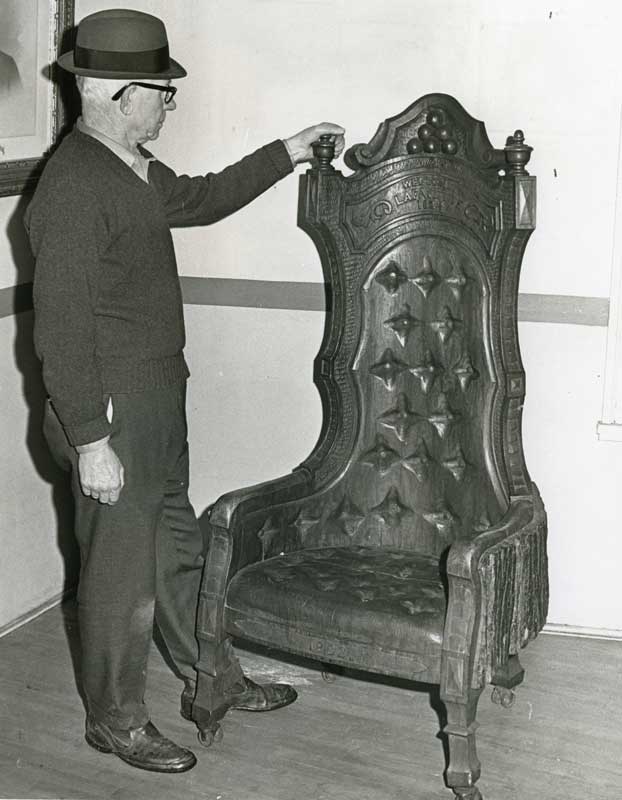 Nahum Littlefield, Jr., carved this seven-foot throne, known as the Lafayette Chair, in 1882 from the trunk of a tree under which the Marquis de Lafayette spoke when he visited Portland in 1825. It is now in the collection of the Portland Fire Museum. Courtesy Maine Historic Preservation Commission
Nahum Littlefield, Jr., carved this seven-foot throne, known as the Lafayette Chair, in 1882 from the trunk of a tree under which the Marquis de Lafayette spoke when he visited Portland in 1825. It is now in the collection of the Portland Fire Museum. Courtesy Maine Historic Preservation Commission
Nahum Littlefield, Sr., his three sons, and other carvers of the era created works that we marvel at today. In 1900, Portland carver Edward S. Griffin, a contemporary of the Littlefields, observed the passing of this highly skilled trade. “The ship carver’s occupation is gone,” he wrote. “In the old days the ship sailing into port without a figurehead at the bow was like an unpolished shoe. It was all the fad and entered into the plans of a vessel about as much as the hull or rigging. It gave a finished appearance to the craft and was not an expensive addition either.”
✮
A native of Portland, Earle G. Shettleworth, Jr. directed the Maine Historic Preservation Commission from 1976 to 2015 and has served as Maine State Historian since 2004.






